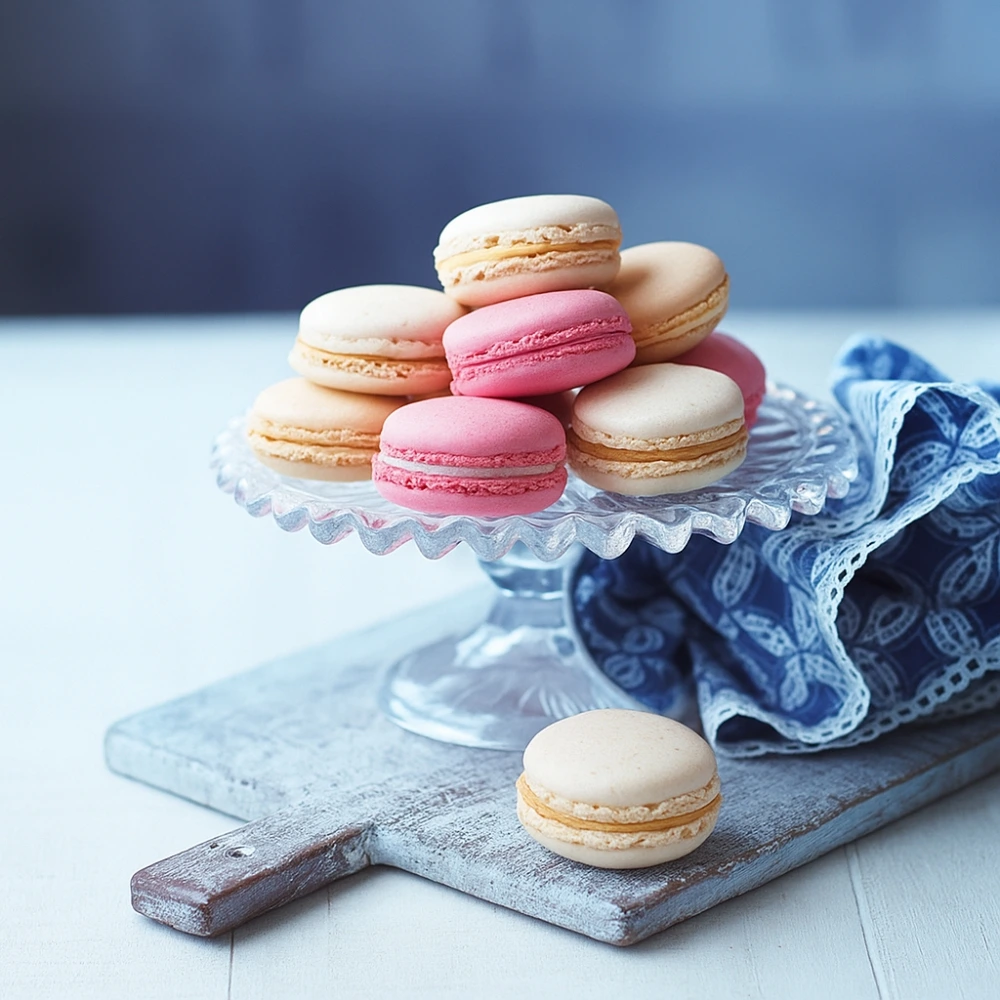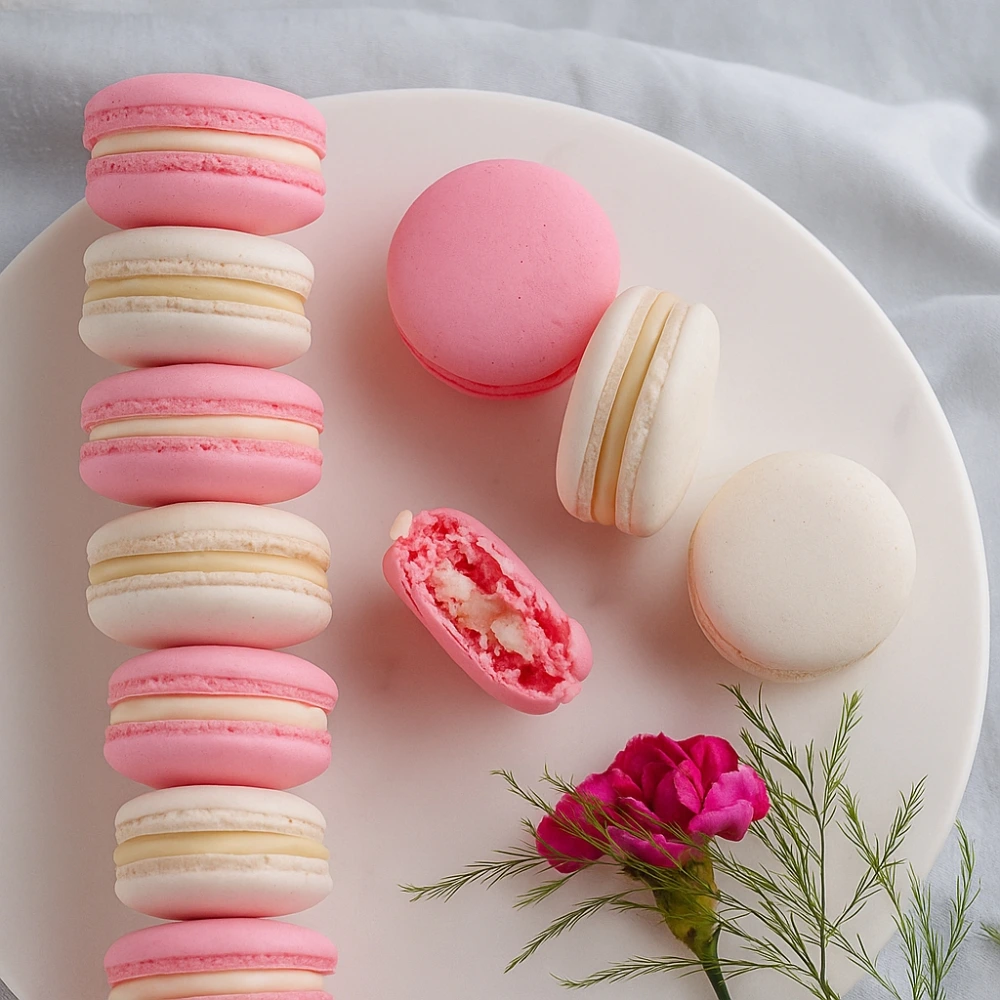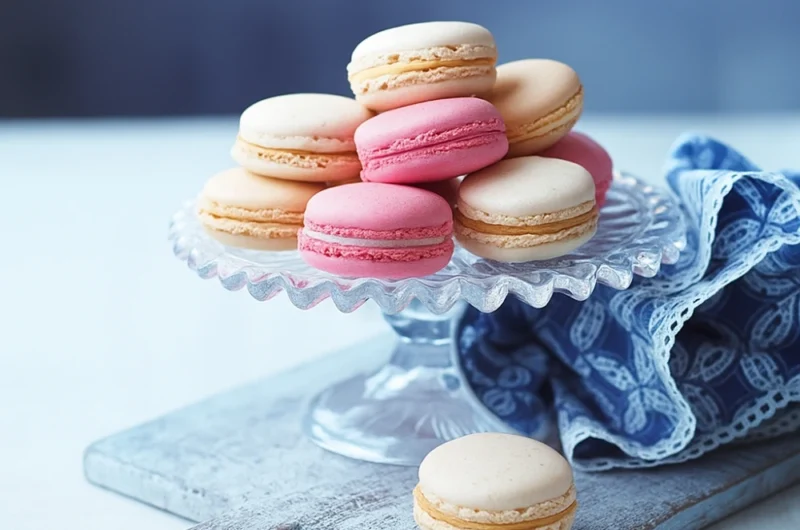The Best Fluffy Pancakes recipe you will fall in love with. Full of tips and tricks to help you make the best pancakes.
French Macaron Recipe

Let’s be honest—French macarons have probably broken your heart more than once. Those delicate, colorful sandwich cookies with their signature “feet” and smooth tops seem deceptively simple, yet they’re notorious for driving even experienced bakers to tears. Cracked tops, hollow shells, no feet, or worse—complete disaster batches that go straight into the trash.
Hi, I’m here to change that story. As a pastry chef with over a decade of experience perfecting French macarons, I’ve made every mistake in the book (and then some). This comprehensive guide represents years of testing, failing, adjusting, and finally mastering the art of consistent macaron success.
What makes this guide different:
- Science-backed techniques simplified for home bakers
- Visual troubleshooting with real examples
- Interactive elements to build your confidence
- The most comprehensive problem-solving guide you’ll find anywhere
Keys to Success Summary
- Precise measurements: Use a kitchen scale—no exceptions
- Proper macaronage: The folding technique that makes or breaks your macarons
- Oven temperature accuracy: Your oven dial is lying to you
- Patience with resting: That skin formation is crucial
- Quality ingredients: Especially finely ground almond flour
Deep Dive: Ingredients Matter More Than You Think
Almond Flour: The Foundation of Great Macarons
Not all almond flour is created equal. The difference between success and failure often starts here.
What to look for:
- Finely ground almond flour (not almond meal, which is too coarse)
- Blanched almonds (skins removed)
- Fresh product with minimal oil separation
Recommended brands:
- Bob’s Red Mill Super Fine Almond Flour
- Anthony’s Blanched Almond Flour
- Wellbee’s Super Fine Almond Flour
Storage tip: Keep almond flour in the refrigerator or freezer to prevent oil rancidity.
Egg Whites: The Science of Aging
Aged egg whites are a game-changer, though not absolutely mandatory.
Why aging works:
- Reduces moisture content
- Breaks down proteins for better stability
- Creates stronger meringue structure
How to age: Separate eggs, cover loosely with plastic wrap, leave at room temperature for 24-48 hours.
Temperature matters: Room temperature egg whites whip faster and create more stable foam.
Sugar’s Dual Role
Granulated sugar (25g): Stabilizes meringue, creates structure Powdered sugar (200g): Provides structure and sweetness to shells, contains cornstarch for stability
Gel Food Coloring vs. Liquid
Always use gel or powder coloring—never liquid. Liquid colorings add moisture that can destabilize your batter and prevent proper feet formation.
Essential Equipment: Your Macaron Success Toolkit
Kitchen Scale: Non-Negotiable
Macarons are a science experiment disguised as baking. Volume measurements are your enemy here.
Why precision matters:
- 5-gram difference can affect texture
- Proper ratios ensure structural integrity
- Consistency between batches
Recommended: OXO Good Grips Food Scale or Escali Primo Digital Scale
Stand Mixer: Your Meringue Powerhouse
While you can make macarons with a hand mixer, a stand mixer gives you:
- Consistent, powerful mixing
- Hands-free operation for multitasking
- Better volume and stability in meringue
Pro tip: Use the whisk attachment, not the paddle.
Piping Equipment
Piping bags: Disposable or reusable, 12-16 inch length Tips: Round tips, size 10-12 work best Alternative: Cut a ½-inch opening in a sturdy zip-top bag
Baking Surface Showdown
| Feature | Silicone Mats | Parchment Paper |
|---|---|---|
| Reusability | Excellent | Single use |
| Heat distribution | Even | Good |
| Easy removal | Excellent | Can stick |
| Cost over time | Lower | Higher |
| Storage | Takes space | Minimal |
Winner: Silicone mats for consistent results
Oven Thermometer: The Truth-Teller
Your oven’s built-in thermometer can be off by 25-50°F. An independent oven thermometer is essential for:
- Accurate temperature readings
- Consistent results
- Preventing over/under-baking
The Step-by-Step Masterclass
Step 1: Preparing the Dry Ingredients
The technique: Sift almond flour and powdered sugar together twice through a fine-mesh sieve.
Why this matters: Removes lumps that cause cracked shells and creates uniform texture.
Pro tip: Don’t force large lumps through—discard them or process separately in a food processor.
Visual check: Your mixture should look like fine, powdery snow with no visible chunks.
Step 2: The Perfect Meringue
Starting point: Room temperature aged egg whites in a spotlessly clean bowl.
Technique breakdown:
- Begin whipping on medium speed until foamy (1-2 minutes)
- Add cream of tartar if using
- Continue to soft peaks (2-3 minutes)
- Gradually add granulated sugar while mixing
- Increase to medium-high speed
- Whip to stiff, glossy peaks (3-5 minutes total)
Perfect meringue looks like: Glossy, white peaks that hold their shape when the whisk is lifted.
Common mistake: Over-whipping creates a grainy, separated meringue that won’t fold properly.
Step 3: The Macaronage – Where Magic Happens
This is the most critical step. Macaronage is the folding technique that combines your meringue with dry ingredients.
The goal: Create a flowing, lava-like batter that ribbons smoothly.
Technique:
- Add 1/3 of dry ingredients to meringue
- Fold from bottom up, pressing against bowl sides
- Add food coloring now if using
- Continue folding in remaining dry ingredients
- Test consistency with the “ribbon test”
Ribbon test: Lift batter with spatula—it should flow like thick ribbons and disappear back into the mixture within 8-10 seconds.
Under-mixed signs: Batter doesn’t flow, thick ribbons that don’t disappear Over-mixed signs: Batter runs like water, no body or structure
Step 4: Piping Perfection
Preparation: Fill piping bag, twist top to seal, practice pressure on parchment.
Technique:
- Hold bag at 90-degree angle to surface
- Pipe steady, consistent pressure
- Stop squeezing before lifting
- Aim for 1.5-inch circles with space between
Spacing matters: Leave 1 inch between cookies—they don’t spread much but need airflow.
Step 5: The Rest Phase – Building That Skin
Why rest? Surface drying creates a skin that allows proper “feet” formation during baking.
How long: 30-60 minutes, depending on humidity Ready when: You can gently touch the surface without batter sticking to your finger Patience pays: Rushing this step is a major cause of failure
Step 6: Baking Science in Action
Temperature: 300°F (150°C) – lower than most cookie recipes Time: 12-15 minutes, no opening the oven door Positioning: Center rack for even heat distribution
What happens during baking:
- First 5 minutes: Feet formation begins
- Minutes 5-10: Feet fully develop, shells set
- Final minutes: Interior cooks through
Doneness test: Gently wiggle a macaron—it shouldn’t move on its base.

The Science of Macarons: Understanding the Why
Meringue Stability Science
Egg white proteins denature when whipped, creating a foam structure. Sugar stabilizes this foam by:
- Binding water molecules
- Creating viscosity
- Preventing over-coagulation
Macaronage Demystified
This folding technique creates an emulsion between the fat-rich almond flour and water-based meringue. Perfect macaronage achieves:
- Even distribution of ingredients
- Proper air retention
- Flow characteristics for smooth shells
The Drying Phase Explained
Surface moisture evaporation creates a protective skin that:
- Prevents cracking during expansion
- Creates upward pressure for feet formation
- Allows controlled expansion during baking
Oven Heat Dynamics
Macarons need gentle, even heat. High temperatures cause:
- Rapid surface setting before interior expansion
- Cracked tops
- Hollow shells from steam pockets
The Ultimate Troubleshooting Guide
Problem: Cracked Tops
What it looks like: Rough, broken surface instead of smooth dome
Photo reference: [Imagine clear photos showing cracked vs. smooth tops]
Causes:
- Oven temperature too high
- Insufficient resting time
- Over-mixed meringue
- Oven door opened during baking
Solutions:
- Use oven thermometer, reduce temperature by 25°F
- Rest until completely skin-formed
- Stop mixing at stiff peaks
- Be patient—don’t peek!
Problem: No Feet Formation
What it looks like: Flat cookies without the characteristic ruffle base
Causes:
- Under-rested batter
- Humid environment
- Incorrect oven temperature
- Over-mixed batter
Solutions:
- Extend resting time to 60+ minutes
- Use dehumidifier or air conditioning
- Calibrate oven temperature
- Practice macaronage technique
Problem: Hollow Shells
What it looks like: Empty space between top and bottom shells
Causes:
- Under-macaronage
- Over-whipped meringue
- Oven too hot
- Over-baking
Solutions:
- Fold batter more thoroughly
- Stop at glossy stiff peaks
- Reduce oven temperature
- Test doneness earlier
Problem: Lacy/Spreading Shells
What it looks like: Thin, spread-out cookies with holey surfaces
Causes:
- Over-macaronage
- Too much liquid (coloring, flavoring)
- Old almond flour
- Insufficient drying
Solutions:
- Stop folding sooner in macaronage
- Use gel coloring only
- Check almond flour freshness
- Ensure complete surface drying
Problem: Chewy/Tough Texture
What it looks like: Dense, rubber-like cookies
Causes:
- Over-baking
- Old egg whites
- Incorrect ratios
- High humidity
Solutions:
- Reduce baking time by 2-3 minutes
- Use fresh eggs
- Double-check measurements
- Control kitchen environment
Common Questions & Expert Answers
Do I really need a kitchen scale?
Short answer: Yes, absolutely.
Why it matters: Macarons are chemistry. A 10-gram difference in almond flour can mean the difference between success and failure. Volume measurements are inconsistent and unreliable for precise baking.
How do I know when my meringue is ready?
Visual test: Stiff, glossy peaks that hold their shape when the whisk is lifted. Bowl test: Turn bowl upside down—meringue shouldn’t budge. Texture: Smooth, not grainy or separated.
What exactly is macaronage?
Definition: The folding technique that combines dry ingredients with meringue. Goal: Create flowing, ribbon-like batter that’s neither too thick nor too thin. Key: Fold from bottom up, pressing against bowl sides to break down air bubbles while maintaining some structure.
How long do macarons last?
Room temperature: 2-3 days in airtight container Refrigerated: 1 week in airtight container Frozen: 3 months in freezer-safe container
Pro tip: Macarons actually improve after 24 hours as shells soften and flavors meld.
Can I freeze macarons?
Yes! Freeze assembled macarons in single layers, separated by parchment. Thaw at room temperature for 30 minutes before serving.
French vs. Italian vs. Swiss method—which is best?
French method (this recipe): Easiest for beginners, uses raw meringue Italian method: Hot sugar syrup creates more stable meringue, professional favorite Swiss method: Heated egg whites, middle ground between French and Italian
Recommendation: Master French method first—it teaches fundamental techniques.
Can I make macarons without almond flour?
Short answer: Not traditional macarons.
Alternatives for nut allergies:
- Sunflower seed flour (closest substitute)
- Pumpkin seed flour
- Powdered freeze-dried fruits
Note: Results will differ in texture, flavor, and appearance.
Macaron Flavor Variations & Fillings
Shell Flavor Variations
Chocolate shells: Replace 20g almond flour with cocoa powder Matcha shells: Add 1-2 teaspoons matcha powder to dry ingredients Fruit flavors: Use freeze-dried fruit powder (strawberry, raspberry) Spiced shells: Add cinnamon, cardamom, or vanilla powder
Classic Filling Options
Basic Ganache (for 15 macarons):
- 100ml heavy cream
- 100g chocolate, chopped
- Heat cream, pour over chocolate, whisk until smooth
Swiss Buttercream:
- 2 egg whites
- 100g granulated sugar
- 150g butter, room temperature
- Heat sugar and whites to 160°F, whip to stiff peaks, add butter gradually
Fruit Curd:
- Perfect for lemon, passionfruit, or berry flavors
- Links to detailed curd recipes for complex flavors
Storage & Freezing Mastery
Optimal Storage Conditions
Temperature: Cool, dry environment (65-70°F ideal) Container: Airtight containers with tight-fitting lids Layering: Single layers with parchment between if stacking Moisture control: Silica gel packets for humid climates
Shelf Life Guidelines
| Storage Method | Unfilled Shells | Filled Macarons |
|---|---|---|
| Room temp | 1 week | 2-3 days |
| Refrigerated | 2 weeks | 1 week |
| Frozen | 3 months | 3 months |
Freezing Best Practices
- Cool completely before freezing
- Flash freeze on baking sheets first
- Transfer to containers once solid
- Label with date and flavor
- Thaw gradually at room temperature
Conclusion: Your Journey to Macaron Mastery Starts Now
You now have everything you need to create consistently beautiful, delicious French macarons. Remember, even experienced bakers had failures along the way—it’s all part of the learning process. The key is understanding the science behind each step and practicing the techniques until they become second nature.
Your next steps:
- Gather quality ingredients and proper equipment
- Start with the basic recipe before attempting variations
- Document your results—photos help you learn from both successes and failures
- Be patient with yourself and the process
The satisfaction of biting into a perfect macaron you made yourself is unmatched. Those smooth tops, delicate feet, and creamy centers are worth every moment of practice.
Join the community: Share your macaron photos and questions in the comments below. I personally respond to help troubleshoot any issues you encounter. Together, we’ll turn you into a macaron master!
Ready to start baking? Pin this recipe, gather your ingredients, and let’s create some magic in your kitchen. Your perfect macarons are just one batch away.
French Macaron Recipe
Course: DessertCuisine: French20-24
sandwich cookies45
minutes15
minutes70
kcalIngredients
1 cup (100g) almond flour
1 3/4 cups (200g) powdered sugar
3 large egg whites, room temperature
1/4 cup (50g) granulated sugar
1/2 teaspoon cream of tartar (optional)
Gel food coloring (optional)
Buttercream, ganache, or jam for filling
Directions
- Prepare dry mixture – Sift together almond flour and powdered sugar. Set aside.
- Make meringue – Beat egg whites until foamy, add cream of tartar, then gradually add granulated sugar. Whip to stiff, glossy peaks.
- Macaronage – Gently fold in the dry mixture with a spatula until batter flows like lava and ribbons off the spatula. Add food coloring if desired.
- Pipe shells – Transfer batter to a piping bag with a round tip. Pipe small rounds onto a parchment-lined baking sheet.
- Rest shells – Let piped macarons sit at room temperature 30–60 minutes until tops are dry to the touch.
- Bake – Preheat oven to 300°F (150°C). Bake 12–15 minutes, rotating halfway through. Shells should rise with “feet” and not brown.
- Cool – Let macarons cool completely before removing from parchment.
- Fill – Sandwich two shells with buttercream, ganache, or jam.
- Mature – For best texture, refrigerate filled macarons in an airtight container 24 hours, then bring to room temp before serving.

